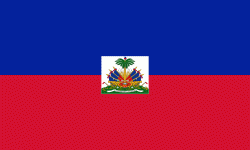Port-au-Prince Arrondissement (Arrondissement de Port-au-Prince)
Port-au-Prince (Pòtoprens) is an arrondissement in the Ouest department of Haiti. It had 2,109,516 inhabitants at the 2003 Census which was estimated to have risen to 2,759,991 in 2015 in an area of 735.78 sq km (284.09 sq mi). Postal codes in the Port-au-Prince Arrondissement start with the number 61.
The arondissement consists of the following communes:
* Port-au-Prince
* Carrefour
* Cité Soleil
* Delmas
* Gressier
* Kenscoff
* Pétion-Ville
* Tabarre
The arondissement consists of the following communes:
* Port-au-Prince
* Carrefour
* Cité Soleil
* Delmas
* Gressier
* Kenscoff
* Pétion-Ville
* Tabarre
Map - Port-au-Prince Arrondissement (Arrondissement de Port-au-Prince)
Map
Country - Haiti
 |
 |
| Flag of Haiti | |
The island was originally inhabited by the indigenous Taíno people, who originated in South America. The first Europeans arrived on 5 December 1492 during the first voyage of Christopher Columbus, who initially believed he had found India or China. Columbus subsequently founded the first European settlement in the Americas, La Navidad, on what is now the northeastern coast of Haiti. The island was claimed by Spain and named La Española, forming part of the Spanish Empire until the early 17th century. However, competing claims and settlements by the French led to the western portion of the island being ceded to France in 1697, which was subsequently named Saint-Domingue. French colonists established lucrative sugarcane plantations, worked by vast numbers of slaves brought from Africa, which made the colony one of the richest in the world.
Currency / Language
| ISO | Currency | Symbol | Significant figures |
|---|---|---|---|
| HTG | Haitian gourde | G | 2 |
| USD | United States dollar | $ | 2 |
| ISO | Language |
|---|---|
| FR | French language |
| HT | Haitian Creole language |















